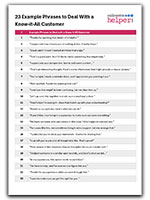In any contact centre, interacting with “know-it-all” customers can be challenging, but it’s also an opportunity to demonstrate expertise and build customer trust.
These customers often come prepared with their own research and may question the advice provided. While this interaction may seem demanding, it presents a chance to acknowledge their insights and reinforce the agent’s knowledgeable and supportive role.
“The best way to understand the customer is to put yourself in their shoes. Something has caused them to believe they know best. Unpick that and you can work together to find an ideal resolution,” says Justin Robbins, Founder & Principal Analyst, Metric Sherpa.
8 Ways to Deal With a Know-It-All Customer
1. Give the Customer Some Recognition
Recognizing a customer’s efforts and insights can go a long way in building rapport and defusing tension, especially with know-it-all customers.
When a customer feels acknowledged for their attention to detail, they’re more likely to feel respected and open to hearing your expertise. Simple, authentic compliments help maintain a positive tone and reinforce mutual respect.
Example phrases:
- “Thanks for spotting that detail – it’s helpful.”
- “I appreciate how closely you’re looking at this. It really helps.”
- “Good catch. I hadn’t looked at it from that angle.”
Using small acknowledgements like these costs nothing. It shows the customer that their input is valued.
2. Avoid Contradicting the Customer
When dealing with know-it-all customers, it’s important to avoid direct contradictions. Pushing back too firmly can come across as dismissive and may create unnecessary tension.
Instead, gently guide the conversation by acknowledging their perspective and suggesting alternative options in a way that feels supportive.
Example phrases:
- “That’s a good point, but I’d like to clarify something that might help.”
- “I appreciate your perspective. Just to add some context…”
- “That’s an interesting thought. Here’s some information that might provide a clearer picture.”
3. Own Any Mistakes That Have Been Made
The key message to give the advisor is to own it. The mistake will come out in the long run anyway.
If an advisor slips up, is not totally clear on a process, or simply misspoke, the key message to give them is to own it. The mistake will come out in the long run anyway.
Come straight out and say it. Making excuses will just drag out the call.
Offer a genuine apology to the customer and, if it’s a significant mistake, the advisor should look to reassure them that they are confident in their ability to answer the customer’s queries, in a humble way.
Example phrases:
- “You’re right; I made a mistake there, and I appreciate you pointing it out.”
- “Well spotted. Thanks for pointing that out.”
- “I see how that might’ve been confusing. Let me clear that up.”
For more examples of ways to offer a genuine apology, read our article: “Sorry for the Inconvenience” – How to Offer a Genuine Apology
4. Walk the Customer Through the Situation
Now the air has been cleared, the advisor can start to regain the customer’s trust. To do this, an advisor can refocus the call and walk through the situation as they see it.
When an advisor does this, they can think about:
- What does the customer see as the key outcomes?
- What does the customer believe is the best path forward?
- Why do they believe that?
Example Phrases:
- “Let’s go over this together to make sure everything’s clear.”
- “Here’s how I’m seeing it – does that match up with your understanding?”
- “Based on our policies, here’s what we can do.”
5. Understand the Last Resorts
When the advisor has made a mistake and the customer just won’t let it go, the conversation becomes very difficult.
If the advisor doesn’t know their last-resort option, they will panic, the conversation will drag on and it becomes a problematic situation for the person on both ends of the line.
A call-escalation policy is a classic last resort. Drawing this out and giving it to advisors as a nice visual aid makes it easy for them to understand their fallback options.
Example phrases:
- “If you’d like, I can bring in a supervisor to make sure we cover everything.”
- “We have someone who specializes in this area. I’d be happy to connect you.”
- “For cases like this, we sometimes bring in extra support. Let me arrange that.”
For more on creating a call-escalation policy, read our article: How to Handle Call Escalations
6. Acknowledge and Compliment
It is also important that the advisor does not become passive and submissive…
It is important that advisors don’t damage rapport by directly telling the customer that they are wrong. Yet it is also important that the advisor does not become passive and submissive just because “they’re a customer”.
A better approach is to acknowledge the customer’s point and compliment them on being:
- Attentive to the key details
- Proactive in their research
- Observant in spotting the mistake
Just make sure that advisors say this in a way that sounds authentic.
Example phrases:
- “Looks like you’ve done your homework – thanks for sharing that.”
- “I can tell you’ve put a lot of thought into this. That’s great!”
For more on giving good compliments in the contact centre, read our article: 100 Great Complimentary Words to Use in Customer Service
7. Present Your Knowledge as “Insider Information”
Once the customer is on a pedestal, respond assertively. Share your knowledge and expertise, before linking back to what the customer has previously stated.
Advisors have dealt with many of these queries before. So what they can do is position their advice to the customer so it seems like they are sharing inside information.
Example phrases:
- “Most people in this situation choose this option because it works well.”
- “I helped someone in a similar spot recently, and here’s what we did…”
- “In my experience, this option tends to work best.”
8. Keep Calm and Manage Your Emotional Response
It’s hard for an advisor to stay calm and manage their emotions when a customer implies that they are wrong, when they are confident they are right.
Of course, there are many things that you could do in the contact centre to improve your team’s emotional intelligence, including:
- Providing resilience training
- Coaching advisors to control their breathing patterns
- Holding open conversations within the team, discussing how they are feeling
One tip from Sangeeta, one of our readers, is to: “Embed your emotional intelligence in your talent screening and include emotional intelligence elements in your interviewing.”
Remind the advisor that the customer must value what they offer, otherwise they wouldn’t be engaging in a conversation with them.
Yet, in these situations, the most important thing to do is remind the advisor that the customer must value what they offer, otherwise they wouldn’t be engaging in a conversation with them.
Also, reassure advisors that it is easy to react to the negative tone of voice. But if they can stay calm and professional, customers will find out for themselves that the advisor’s knowledge is superior.
Example phrases:
- “I’m here to help, and I’m sure we can figure this out.”
- “Thanks for your patience while we work through this.”
- “I want to make sure we get this right for you.”
Printable – 23 Example Phrases to Deal With a Know-It-All Customer
Do you want to download this to share with your team?
Get your free download of 23 Example Phrases to Deal With a Know-It-All Customer now:
Some Final Quick Tips
99% of the time, a customer only becomes a know-it-all once they have lost confidence in the advisor’s ability.
We have shared some great tips for helping to restore this trust – such as walking the customer back through the interaction and sharing “insider information” – but there are other ways to do this.
So, here are some final key pieces of advice to share with your teams who struggle to deal with know-it-all customers.
- Demonstrate an understanding of the problem – Get back to the heart of the problem by reflecting the query back to the customer to show that it has been fully understood
- Lower self-orientation – Think of customers as teammates. It’s good for an advisor to engage with the customer’s vision instead of imposing their own on the customer.
- Know the right questioning techniques – Find out what the customer’s ideal outcomes are. To do this, use questioning techniques, such as filtering, TED questions and leading questions.
For more advice for handling specific types of difficult customers, read our articles:
- Dealing with Angry Customers
- How to Deal With a Customer Who Can’t Stop Talking
- How To Deal With Vulnerable Customers
Author: Charlie Mitchell
Reviewed by: Robyn Coppell
Published On: 31st Oct 2024 - Last modified: 12th Nov 2025
Read more about - Customer Service Strategy, Angry Customers, Call Handling, Rapport, Service Strategy






































